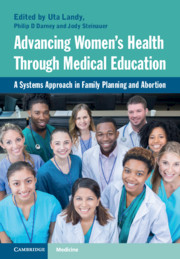 Advancing Women's Health Through Medical Education
Advancing Women's Health Through Medical Education from Section IV - Reproductive Health Services & Abortion Training: Global Examples
Published online by Cambridge University Press: 30 July 2021
Nepal’s transition from highly restrictive abortion laws and high maternal mortality to liberal laws and many fewer maternal deaths provides one of the world’s most impressive examples of the relationship of the two.Nepal’s expansion of access to abortion through an emphasis on self-determination for women and incorporation of abortion training into medical and nursing training are excellent implementation models for other nations where the constraint of women’s rights and abortion services lead to injustice and early death for women.That Nepal accomplished so much for women despite political instability and only modest economic growth supports the importance of the collaboration of ministries of health and education and non-government organizations (NGOs) to progressively expand abortion training to include a wide range of urban and rural practitioners at early and later stages of their training, set standards for education and performance, and systematically evaluate effects on abortion access and safety.
To save this book to your Kindle, first ensure no-reply@cambridge.org is added to your Approved Personal Document E-mail List under your Personal Document Settings on the Manage Your Content and Devices page of your Amazon account. Then enter the ‘name’ part of your Kindle email address below. Find out more about saving to your Kindle.
Note you can select to save to either the @free.kindle.com or @kindle.com variations. ‘@free.kindle.com’ emails are free but can only be saved to your device when it is connected to wi-fi. ‘@kindle.com’ emails can be delivered even when you are not connected to wi-fi, but note that service fees apply.
Find out more about the Kindle Personal Document Service.
To save content items to your account, please confirm that you agree to abide by our usage policies. If this is the first time you use this feature, you will be asked to authorise Cambridge Core to connect with your account. Find out more about saving content to Dropbox.
To save content items to your account, please confirm that you agree to abide by our usage policies. If this is the first time you use this feature, you will be asked to authorise Cambridge Core to connect with your account. Find out more about saving content to Google Drive.